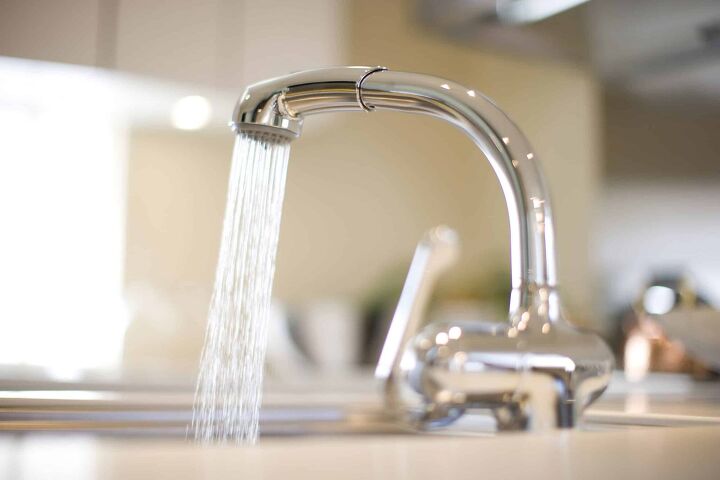Kitchen Faucet Stuck On Spray Mode? (Here's What You Can Do)

Kitchen faucet sprayers can be fantastic features for any kitchen sink setup. Not only do they make it easier to wash rinse your dishes, fruits, and vegetables, but kitchen sink sprayers also make keeping your kitchen sink clean. There are times, however, when a kitchen sink sprayer can give you problems, the biggest of which is when the faucet sprayer is stuck on spray mode.
If your kitchen faucet is stuck on spray mode, you probably have a faulty diverter, clogged screens, or a faulty spring. By changing or adjusting these parts, you can solve the issue and get the kitchen faucet out of spray mode. If this does not solve the problem, you will need a new kitchen faucet.
Related Content: Kitchen Faucet Replacement Cost | Best Faucet Brands | How To Replace A Delta Kitchen Faucet Sprayer Hose | Sink Sprayer Connection Types
Do You Need a Faucet, Fixture, or Pipe Repair or Replacement?
Get free, zero-commitment quotes from pro plumber near you.

Video: Fixing a Broken Sink Sprayer
Methods to Fix a Kitchen Sink Sprayer Stuck on Spray Mode
Single Handle Pull Down/Out Handle
If your kitchen sink features a single handle pull down handle, a solution to the problem can be found with a few simple steps.
Step 1 – Remove the Spray Head
Pull the spray head down and unscrew it from the hose. When you unscrew the spray head be mindful of the gasket assembly inside as it can fall and go down the drain of your sink. The gasket assembly will fall out and most cases so be ready to catch it as soon as you remove the spray head.
Step 2 – Clean the Screens
the next step is to clean the screens. There is one in the gasket assembly and there is another one inside of the spray head near the aerator.
To access the screen near the aerator you will need to use a wrench to remove a portion of the spray head. Cleaning both screens can often solve the problem of a kitchen sink sprayer stuck on spray mode.
If, after reassembly, cleaning the screens does not help solve the problem, continue to the following steps. The following steps will help you adjust the switch screen. Adjusting the switch spring often solves the problem when a simple screen cleaning won’t do the trick.
Step 3 – Remove the Buttons
Beneath the button that switches from stream and spray mode, there is a spring that often becomes too weak and worn out to effectively do its job.
To adjust the spring, you will need to access the spray head assembly inside of the outer casing. The first thing that you will need to do, is to remove the plastic buttons. These can be pried off with a small screwdriver. While doing this, be careful not to break the buttons.
Step 4 -Remove the Outer Casing
To remove the outer casing, all that is required is to unscrew the internal assembly using a small screwdriver. Place the screwdriver along the rim of the internal assembly and unscrew the entire assembly in a concert clockwise Direction. Once unscrewed, the entire assembly can be pulled out of the outer casing.
Step 5 – Accessing the Spring
With the assembly in hand, the final step is to remove the screw which is attached to the spray mode button. As I mentioned, the tool used to remove the screw will change depending on the brand of your pull-down kitchen sink sprayer. However, in most cases, a screwdriver or basic wrench will do the job.
Once unscrewed, the spring should pop right out. To add strength to the spring, simply pull it apart to add about a quarter-inch to the length of the spring. Once you have done that, follow all previous steps in the reverse order to reassemble your kitchen sink sprayer.
Alternative Methods
Sometimes, a complete rebuild of your kitchen sink spray head is something you would rather not do. Fortunately, there are a few other things you can try.
Using Solvents
When a kitchen sink is stuck on spray mode, the problem is most commonly a buildup of minerals inside of the spray head itself. Mineral buildup happens especially quickly in homes with hard water, but it can happen even if the water is not especially hard.
Using solvents to solve blockages is one of the easiest methods you can try. However, the method does require additional time. You can use a solvent made specifically for breaking down and removing mineral buildup. Or, you may just want to use something found around the house, like vinegar. In either case, you will need to soak the spray head overnight.
Using Lubrication
Another common reason for kitchen sink sprayers to get stuck on spray mode is buttons that get stuck. There are several reasons why buttons and levers may get stuck, including mineral buildup, physical damage to the button or lever, or internal parts rusting.
Oftentimes, spraying the edges of the button or switch with a lubricant can help loosen things up enough to get your kitchen sink sprayer working again. While lubricating the switch is certainly one of the easiest methods you can try, it is also usually considered only a short-term solution to the underlying problem.
Complete Replacement
In some cases, replacing the entire spray head is the best way to go. Replacement spray heads are generally inexpensive and replacing your old kitchen sink sprayer with a new one and sure is that all of the hardware, gaskets, switches, are in good condition.
Troubleshooting
Keep in mind that the problem of a kitchen sink sprayer stuck on spray mode is not always due to a faulty spray head. If, for instance, your kitchen sink sprayer has been installed recently, problems associated with long-term use will not apply.
Instead, you may be experiencing a problem with the faucet diverter in your sink. If there is a diverter-related issue, you will likely experience water flow issues other than just a sprayer stuck on spray mode.
There are some common problems that you can check for. If you see water flow is split between the kitchen sink and the sprayer, no water pressure from either, or the inability to switch the water flow despite pressing the switch on the sprayer, chances are good that a faulty diverter is the cause of your problem.
Fixing the Diverter
To clean out the diverter you will need to remove it from the faucet body. The tools you use to disassemble will vary depending on brand and type of faucet, but basic wrenches are generally all you are going to need.
- Remove the Faucet Body: After you have removed the faucet body, take out the diverter and inspect it. When diverter valves are the root of water flow issues, they usually have considerable mineral buildup that hinders them from functioning properly.
- Remove Mineral Deposits: Soak the diverter in a solvent or vinegar to break down the mineral deposits. Soaking should take from 2 to 8 hours, depending on the extent of the problem.
- Reassemble: After soaking, simply brush away any left-over debris and reinstall the diverter into the faucet head.
Do You Need a Faucet, Fixture, or Pipe Repair or Replacement? Get free, zero-commitment quotes from a pro plumber near you: FIND LOCAL PRO PLUMBER.
Related Questions
Why does my kitchen sink have a sprayer?
Sprayers are included in kitchen sinks to make it easier to clean vegetables and rinse your dishes. Instead of supplying one steady stream of water, sprayers provide a shower-like spray that distributes the water evenly.
Do all kitchen sinks come with sprayers?
No. While sprayers on kitchen sinks are quite popular, only certain models include a sprayer. If you would like to have a sprayer on your kitchen sink, there are a couple of different options to choose from. You can either opt for a sprayer attached to the faucet itself or a dedicated pull-out sprayer.
Related Guides

Benjamin is a proud homeowner who loves to write about DIY projects and home improvement projects. Traveling, perfecting his home, and spending time with his family are just a few of the many things that keep him inspired.
More by Benjamin Wright



























